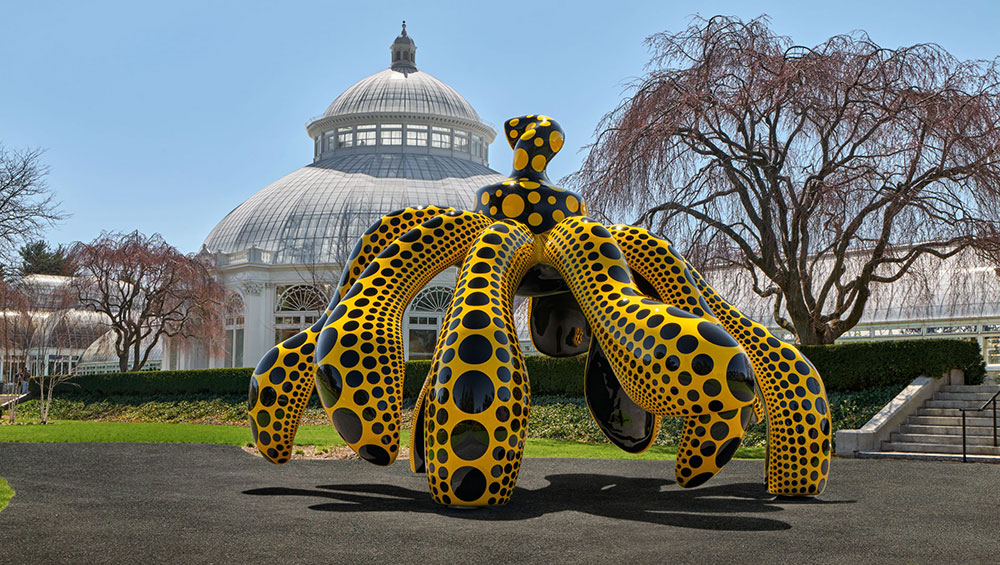
Yayoi Kusama. Dancing Pumpkin, 2020, The New York Botanical Garden. Urethane paint on bronze, 196 7/8 x 116 7/8 x 117 ¼ in (500 x 296.9 x 297.8 cm), Collection of the artist. Courtesy of Ota Fine Arts and David Zwirner. Photo: Robert Benson Photography.
New York Botanical Garden, New York
10 April – 31 October 2021
by LILLY WEI
The sky is a peerless, over-the-rainbow blue, the air is fresh, sun-kissed, trees are flowering, lushly, silkily petalled white, pink, yellow, and the grass is bewitchingly green. Beckoning us towards it, at the intersection of several paths, is a giant sculpture, perhaps of a sun, or a sunflower, or both, its polka-dotted red flames outstretched in greeting, its image doubled, reflected in the dark water of the circular pool it prances atop. Called I Want to Fly to the Universe (2020), the title echoes a wish shared by many, no doubt, after a year of travel restrictions (although more terrestrial destinations would probably satisfy most of us). The expression on the golden face at its centre seems one of astonishment. Perhaps that is because the exhibition is finally on view after a year’s postponement, the pandemic is waning (we hope), it is spring again and people are out and about, here to see it and the other Yayoi Kusama creations that have sprung up all over the New York Botanical Garden (NYBG) in the Bronx, the sole venue for this lively venture by the internationally beloved, 92-year-old Japanese artist. Expertly curated by Mika Yoshitake, Kusama: Cosmic Nature is a jolt of pure joy, a potent remedy after months of isolation and pervasive trauma.
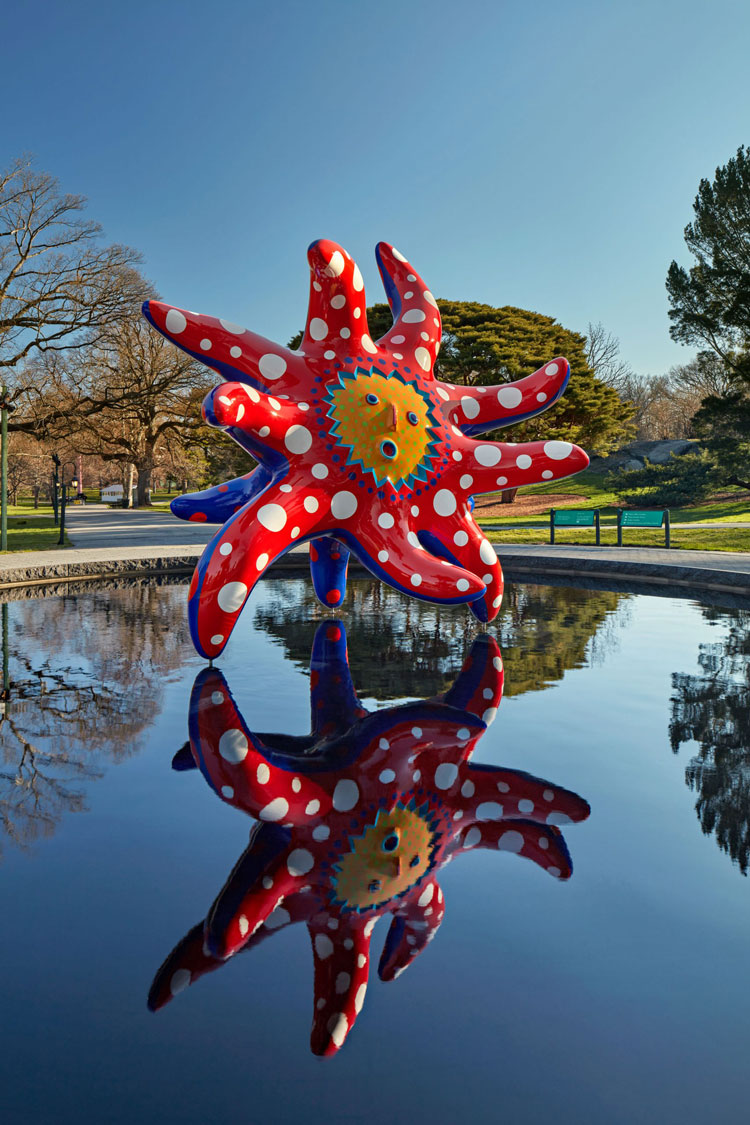
Yayoi Kusama. I Want to Fly to the Universe, 2020, The New York Botanical Garden. Urethane paint on aluminum, 157 3/8 x 169 3/8 x 140 1/8 in (400 x 430 x 356 cm). Collection of the artist. Courtesy of Ota Fine Arts and David Zwirner. Photo: Robert Benson Photography.
The great gift to the public that is the NYBG comprises 250 acres (100 ha) and might sound daunting to those unfamiliar with its grounds, but the works, sited indoors and out, are strategically placed, like a treasure hunt, each drawing you towards the next. And it offers, for once, adequate space to view a Kusama show, usually overrun by her enthusiastic fans. The garden is also Kusama’s co-star in other ways, coupling art and nature, and providing the best of all complementary settings, the plantings, in some instances, inspired by her paintings. There is the additional allure of seasonal change, a compelling reason to return during its more than six-month run.
One of Kusama’s wildly popular infinity rooms, Pumpkins Screaming About Love Beyond Infinity (2017), is installed at the Visitor Center Gallery, near the entrance. The polka-dotted pumpkins are enclosed in a mirrored glass cube, the LED lights gradually shifting from dark to light, like the marking of the passage of time, as one pumpkin, then another and another is illuminated a luminous orange gold, until the cube is filled with an infinity of pumpkins. Although not as immersive or vertiginous as some of the other such rooms, it is still spellbinding. Kusama said: “When I see pumpkins, I cannot efface the joy of them being my everything, nor the awe I hold them in.” And for many of us, when we see pumpkins, polka-dotted, it’s hard not to think of Kusama.
Not far away is Flower Obsession (2017/2021), an “obliteration greenhouse”. Entering, each visitor is given an artificial flower and a floral decal to place wherever desired – on pots of plants, plates, cups, furnishings, walls, floor, windows, the space expected to be overwhelmed by the fake flowers left by legions of visitors by the end of the show.
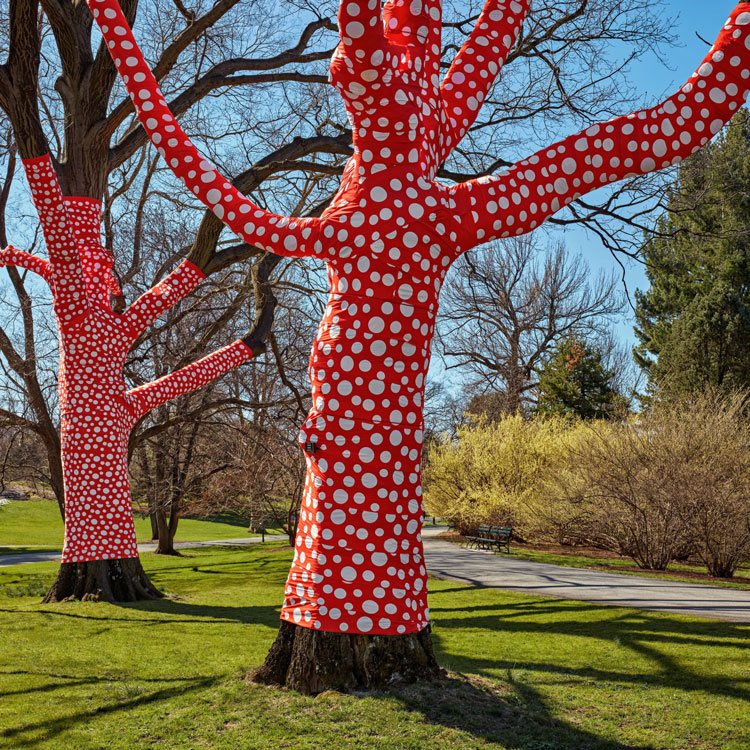
Yayoi Kusama. Ascension of Polka Dots on the Trees, 2002/2021, The New York Botanical Garden. Printed polyester fabric, bungees, and aluminum staples installed on existing trees, Site-specific installation, dimensions variable, Collection of the artist. Photo: Robert Benson Photography.
A stand of great trees past the sun sculpture are shrugged into the equivalent of handsome red body suits, abundantly seeded with white polka dots. Called Ascension of Polka Dots on the Trees (2002/2021), they seem very human and made me think of any number of enchanted trees in fairytales and films. Of her polka dots, she says, in a posted sign (signage and statements by the artist are everywhere, as if she is walking us through): “Our Earth is only one polka dot among a million stars in the cosmos.” We may also remember that it is the only “polka dot” that’s currently available to us, and therefore precious, irreplaceable.
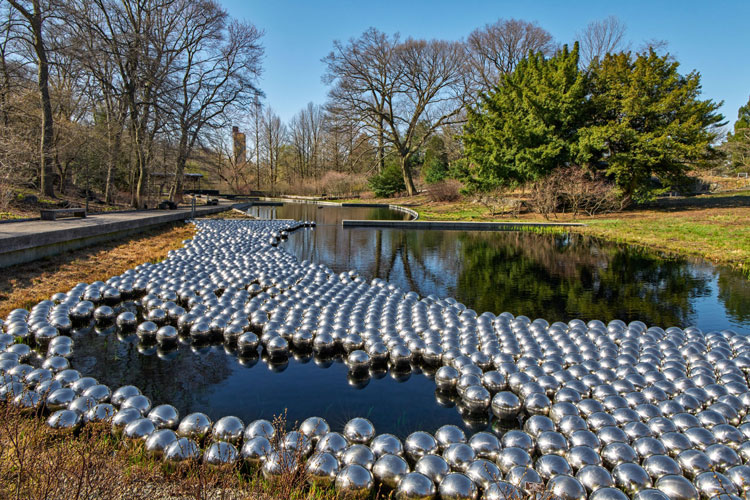
Yayoi Kusama. Narcissus Garden, 1966/2021, The New York Botanical Garden. 1,400 stainless steel spheres. Collection of the artist. Courtesy of Ota Fine Arts, Tokyo/Singapore/ Shanghai; David Zwirner, New York; Victoria Miro, London/Venice. Photo: Robert Benson Photography.
Another outdoor spectacle is Narcissus Garden (1966/2021), which is installed in the channel of water in the Native Plant Garden, a few minutes’ walk away. It is a reprise of her uninvited intervention at the 1966 Venice Biennale (rectified in 1993, when she represented Japan there). The 1,400 stainless steel spheres, about the size of beachballs, drift slowly by, on the currents of wind and water, sometimes emitting a ping as they bump against each other, sparkling in the sunlight, mirroring their surroundings, a commentary on nature as seen through the lens of the manmade, and our general, often blinding, narcissism.
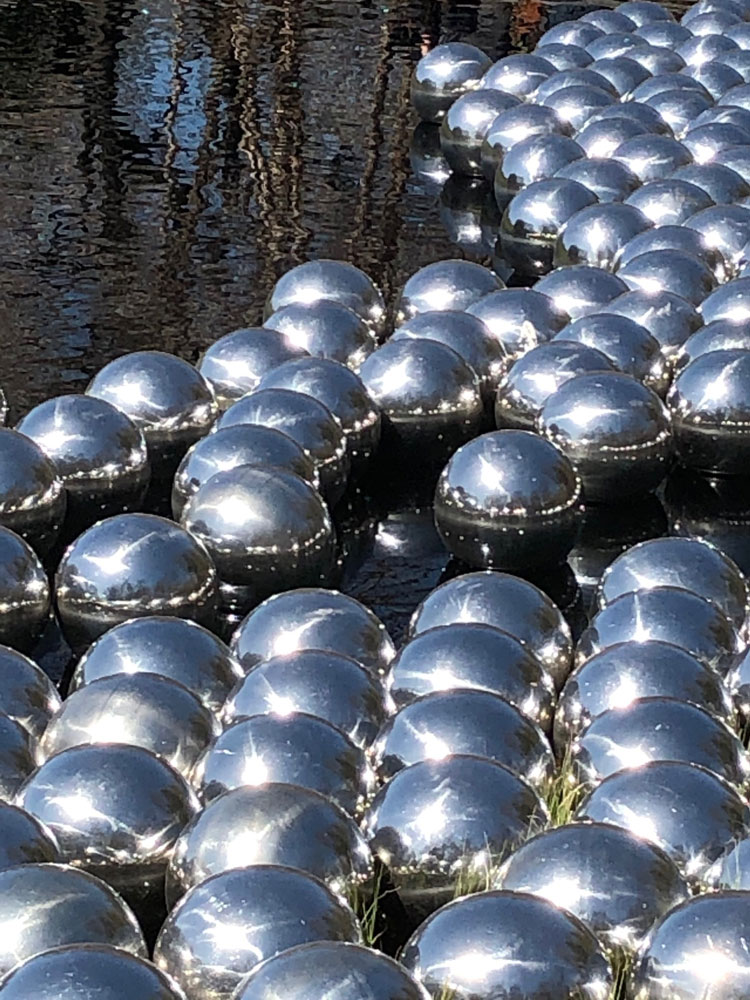
Yayoi Kusama. Narcissus Garden, 1966/2021 (detail), The New York Botanical Garden. Photo: Lilly Wei.
Returning to the circular pool and continuing straight past it, you come to the Enid A Haupt Conservatory, the extravagant glass complex modelled on the Palm House at Kew Gardens in London, as well as Crystal Palace, and the heart of the Botanic Garden. In the plaza in front of the entrance is Dancing Pumpkin (2020), a new black-and-orange beauty. Another fanciful take on a pumpkin, this one resembles a many-armed or many-legged creature that seems to be pirouetting, basking in its own winsomeness, the antithesis, say, of a brooding, menacing Louise Bourgeois spider, although Kusama has her own demons.
Inside, more flowers and pumpkins await. My Soul Blooms Forever (2019) is a whimsical quintet of enlarged, gaily coloured, stainless steel flowers. Showered by light from the vast skylight overhead, they are in yet another colloquy with the real blooms and palm trees around them, another amiable exchange between art and reality. And look for the other Kusama drolleries as you wander through the conservatory’s lush flora: a rococo pink and gold pumpkin; fibreglass tulips in the long pool of the interior courtyard that, later in the season, will be accompanied by flotillas of water lilies and other aquatic marvels; and more.
At the Library are earlier Kusama works, including a sketchbook of 50 or so drawings of keenly observed tree peonies from 1945, made when the artist was 16. They are an engaging testament to her lifelong obsession with nature and its cycles, a legacy of a childhood spent in Matsumoto, among her grandparents’ nurseries. Also present is a suitably themed example of her performance works: Walking Piece (c1966/2021), showing her attired in a floral patterned, cotton candy-pink kimono, holding an umbrella covered with artificial flowers.
We all need cheering up after a year like this last one. So, if you can, visit the New York Botanical Garden to savour the full charismatic force of Kusama’s improbable sorcery. It should help restore your faith in art, life, and the world.